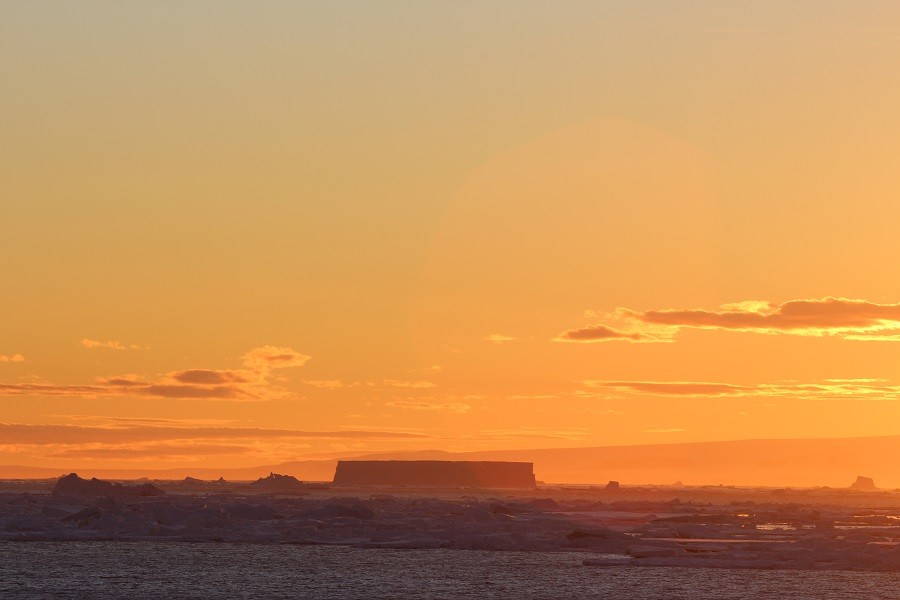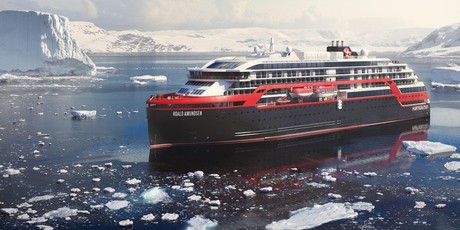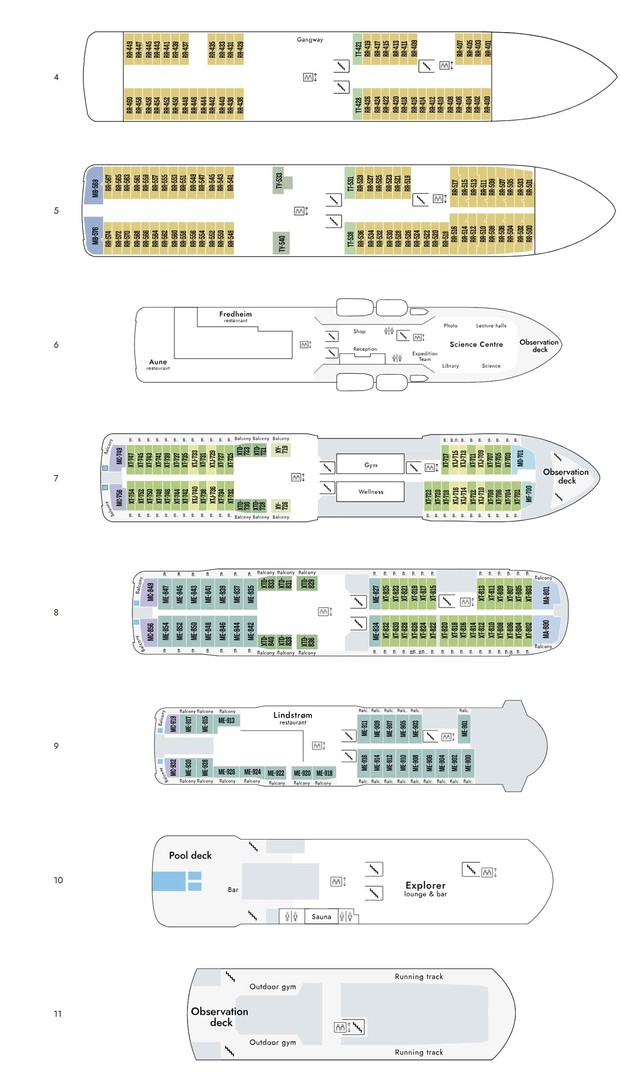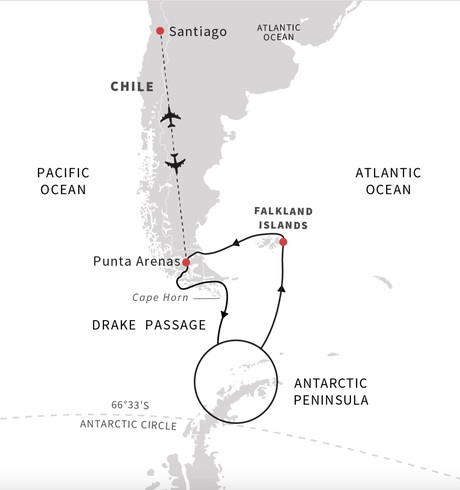
Travel to the White Continent via the Chilean fjords, the Falkland Islands and South Georgia. Once in Antarctica, the sight of mighty glaciers calving into the ocean, flocks of penguins and whales in the icy seas will create indelible memories. On board there is so much to do: Science Center, exciting lectures, and more, all designed to enhance your trip.
Antarctica
Antarctica is isolated from the rest of the world by ocean currents. 90 per cent of the world´s ice is here, 4.000 meters thick, covering the landmass. In winter it is further cut off by sea ice forming off the coast - virtually doubling the size of the continent. In summer, it is a breeding ground for millions of penguins, whales and seals that, for the rest of the year, simply spend their time at sea. Most wildlife thrives on a cornerstone species: krill. The krill population in the Southern Ocean represents the largest biomass of one species on Earth – including human beings.
The Falklands
After exploring this superlative-exhausting continent, we set course back for The Falkland Islands. The Falklands consist of two large islands and around 700 smaller ones. Captain John Strong of HMS Welfare made the first recorded landing here in 1690. We will continue our lecture series that focuses on the dramatic history and diverse wildlife of the islands as we keep a watch for wandering albatross.
Includes
- Expedition on a full board basis
- One hotel night in Santiago de Chile before the voyage including breakfast
- Transfer hotel to airport in Santiago de Chile
- Return economy flights Santiago de Chile to Punta Arenas
- Transfers in Punta Arenas including an orientation tour
- Wind and water resistant jacket
- Landings with small boats and activities on board and ashore
- Professional English speaking Expedition team that gives lectures as well as accompanying landings and activities
- Free tea and coffee
There are no future departures for this trip at this stage.
The capital of Chile is exciting and diverse. There is a lot to discover here, from the Andean glaciers at the city borders, tall mountains and skyscrapers to quiet parks, colonial architecture, bohemian quarters and the fast-flowing Mapacho River. Your adventure starts with an overnight hotel stay here.
You fly to Punta Arenas where MS Roald Amundsen is ready for this expedition to Antarctica.
Enjoy cruising through the Beagle Channel, with channels, fjords and mountains plunging straight into the icy water. This wild and remote area seems almost undisturbed by humans. The ice has scoured its way between the mountains, leaving isolated islands and hidden bays and creating the unique fjord landscape of Chile.
When ranking the most iconic places on Earth, Cape Horn is high on the list. At almost 56 degrees south, it is the southernmost point of South America. Before the Panama Canal, seafarers had to pass this infamous rocky island in order to cross from one side of the Americas to the other. We will do our best to make a landing on Cape Horn – however, this is an area known for high seas and challenging conditions and if we make it this will be a great achievement. Then MS Roald Amundsen will use 1 ½ to 2 days to cross the Drake Passage, depending on the weather conditions. This enormous churn of water is funnelled by western wind drift from the Pacific through the Drake Passage and into the Scotia Sea to the east. The Drake Passage is part of the Antarctic Circumpolar Current, the most voluminous current in the world. About 95 to 150 million cubic metres of water per second are transported from west to east. As you cross the Drake, you sail over the mid ocean West Scotia Ridge and over the nearly 6.000 metre deep South Shetland Trench. The weather can be terrible on the Drake, but it can also be placid, often called the “Drake Lake”. Usually, it’s somewhere in between.
Antarctica is isolated from the rest of the world by ocean currents. 90 per cent of the world´s ice is here, 4.000 meters thick, covering the landmass. In winter it is further cut off by sea ice forming off the coast - virtually doubling the size of the continent. In summer, it is a breeding ground for millions of penguins, whales and seals that, for the rest of the year, simply spend their time at sea. Most wildlife thrives on a cornerstone species: krill. The krill population in the Southern Ocean represents the largest biomass of one species on Earth – including human beings. As outlined in the Antarctic Treaty, this is a continent dedicated to peace, science and tourism. No human activity is allowed to alter the perfect natural balance. We are visiting a place that has evolved through millenniums without human interference. Therefore, we adhere to very strict environmental guidelines and rules. We want to leave nothing but footprints and take nothing but pictures!
What is so overwhelming about Antarctica is that its location makes every voyage to the continent an expedition. Even the most sophisticated technology cannot override some of the climatic challenges that are a part of this environment. Therefore, we need to be pragmatic; we change landings, re-route and shift plans as we go along. This also means that we will take advantage of the often ideal conditions – spend hours ashore, on the water with kayaks, hiking or simply cruising amongst huge pods of whales. Weather, wind and ice conditions have a great influence on our programme and schedule. We will attempt to land several places, including Deception Island, Half Moon Island, Brown Bluff, Cuverville Island and Neko Harbour. All of these places are serene and offer untouched nature, oportunities to observe penguin colonies, seals, , glaciers, icebergs in every shape and colour and old whaling stations and. It´s hard to sum up all the impressions you will gain. As a well-known quote from veteran Antarctic travellers puts it: “If you can describe Antarctica with words, you have probably never been there.”
After exploring this superlative-exhausting continent, we set course back for The Falkland Islands. The Falklands consist of two large islands and around 700 smaller ones. Captain John Strong of HMS Welfare made the first recorded landing here in 1690. We will continue our lecture series that focuses on the dramatic history and diverse wildlife of the islands as we keep a watch for wandering albatross.
Having just been in Antarctica, it might seem a bit surreal to arrive in a town that looks like a miniature England, with red phone boxes, red buses and English pubs. Stanley is the capital on the Falkland Islands. Roam the city streets, the town is easy enough to discover in a day on foot, or join one of the excursions to explore the wilderness and wildlife in the surroundings. The Falklands are teeming with wonders of wildlife and nature. This is an unpolluted environment with fantastically clear blue skies, seamless horizons, vast open spaces and stunning white sand beaches. As we reach the westernmost settled outposts in the Falklands you will see remote farms that have been family owned for six or seven generations. The sheep graze alongside immense colonies of albatross and rockhopper penguins, while predatory striated caracaras patrol overhead and upland geese forage at the water’s edge. Bird lovers will rejoice if we go ashore on Carcass Island. This is a bird paradise with several ducks, geese, penguins, albatrosses, caracaras and wrens. It is also one of few islands down here with trees. We use our small boats to go ashore for exploring, hiking or take a closer look at all the birds.
As we complete the loop of the Magellan Strait, we will have a recap of everything we have experienced on this expedition. Make sure you spend some time on deck looking for wildlife.
We arrive back in Punta Arenas in the morning. After the flight back to Santiago de Chile, you can extend your vacation with a post voyage extension to experience the impressive region.
Roald Amundsen

| Launched | 2019 |
|---|
Launched in 2019, The state of the art vessel features new and environmentally sustainable hybrid technology that will reduce fuel consumption and show the world that hybrid propulsion on large ships is possible.
MS Roald Amundsen is the first of two hybrid ships to be launched cutting emissions by sailing with electrical propulsion. Hybrid technology, combined with the advanced construction of the hull and effective use of electricity on board will reduce fuel consumption and CO2-emissions on the ships by 20 percent.
The future of shipping will be silent and emission free. MS Roald Amundsen will lead the way towards an even more sustainable way of traveling. Sailing on electrical power is not only a great benefit for the environment, but it will also enhance the impact of experiencing nature for the guests. The ship will be specially constructed for voyages in polar waters and serve as a comfortable basecamp at sea – bringing adventurers from all over the world to the most spectacular destinations in the most sustainable way.
These ships combine state-of-the-art technology together with a premium onboard experience. All cabins are outside, half have private balconies, and aft suites even boast private outdoor Jacuzzis, to soak up the stunning scenery in style.
Facilities on board
One of the most eye-catching exterior design features of the ships will be the two-level indoor/outdoor Observation Deck wrapped around the top of the ships’ raked bow. In a vast area behind it, you’ll find the core of the onboard experience: Amundsen Science Center.
Packed with state of the art technology and high tech gadgets such as touch screens and science equipment, the immersive edutainment area will be the place guests and staff/crew meet, mingle and create a deeper understanding for the areas they explore. The flexible venue will feature lecture spaces, a small library, and speciality areas for workshops in photography, biology, and more.
The stunning scenery will be reflected in a rich and comfortable interior design. Scandinavian materials from nature, such as granite, oak, birch and wool will be used to create relaxed and stylish cabins and public areas. All cabins are outside, 50 % will have private balconies, aft suites will feature private outdoor Jacuzzis with spectacular views.



